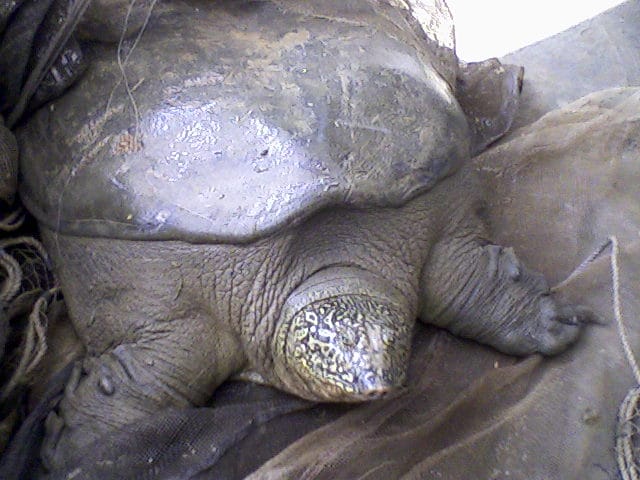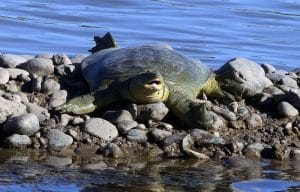Rafetus swinhoei (Yangtze Giant Softshell Turtle)
Home > Turtle Database > Rafetus swinhoei (Yangtze Giant Softshell Turtle)
Rafetus swinhoei, known as the Yangtze Giant Softshell Turtle, is one of the rarest turtles in the world. It holds the unfortunate title of being on the brink of extinction, with only a handful of individuals confirmed in existence.
Native Turtle Species Map – Find Turtles by Region
Scientific Classification
Kingdom: Animalia
Phylum: Chordata
Class: Reptilia
Order: Testudines
Family: Trionychidae
Genus: Rafetus
Species: R. swinhoei
Common Names
Yangtze Giant Softshell Turtle
Shanghai Softshell Turtle
Swinhoe’s Softshell Turtle
This Hilarious Turtle Book Might Know Your Pet Better Than You Do
Let’s be real—most turtle care guides feel like reading a textbook written by a sleep-deprived zookeeper.
This one’s not that.
Told from the snarky point of view of a grumpy, judgmental turtle, 21 Turtle Truths You’ll Never Read in a Care Guide is packed with sarcasm, sass, and surprisingly useful insights.
And hey—you don’t have to commit to the whole thing just yet.
Grab 2 free truths from the ebook and get a taste of what your turtle really thinks about your setup, your food choices, and that weird plastic palm tree.
It’s funny, it’s honest, and if you’ve ever owned a turtle who glares at you like you’re the problem—you’ll feel seen.
Identification
Description
This massive freshwater turtle has a flattened, leathery shell instead of a hard carapace. It can grow up to 100 cm (39 inches) in length and weigh over 100 kg (220 lbs). Its skin is grayish-green, sometimes with dark speckles. The long, tubular snout allows it to breathe while submerged, and its strong limbs are webbed for swimming.
Sexual Dimorphism
Males tend to have longer, thicker tails compared to females. Females are often larger in body size, but due to the rarity of this species, observations on dimorphism remain limited.
Check more turtles from the Rafetus genus
Native Origin and Distribution
Geographical Range
Historically, this species was found in China and northern Vietnam, mainly in the Yangtze River, Taihu Lake, and the Red River system. Today, confirmed individuals are extremely scarce, with recent reports from Suzhou Zoo and wild populations in Vietnam.
Preferred Habitat
Yangtze Giant Softshell Turtles thrive in large, slow-moving rivers, lakes, and wetlands with sandy or muddy bottoms. They rely on deep water for safety and bask on the shore occasionally.
Behavior
Feeding Habits
They are carnivorous, feeding on fish, crustaceans, mollusks, and aquatic plants. Their powerful jaws help crush hard-shelled prey.
Predators
Adult turtles have few natural predators due to their size, but eggs and hatchlings are vulnerable to birds, fish, and mammals.
Reproduction
Breeding Season
Breeding occurs in late spring and early summer, with females laying eggs in sandy riverbanks.
Reproductive Method
Like most turtles, they reproduce through oviposition. Females lay clutches of 20–80 eggs, but successful hatching has become rare due to habitat destruction and pollution.
Conservation
Extinction Status
Critically Endangered (IUCN Red List)
Threats
Habitat loss due to dam construction, pollution, and wetland destruction has drastically reduced populations. Overfishing and poaching for meat and traditional medicine have further harmed the species.
Conservation Measures
Conservationists have tried to breed the last known captive pair in China, but without success. Efforts continue in Vietnam to find and protect wild individuals. Researchers are also restoring wetland habitats and launching awareness campaigns.
Economic Importance
Historically, this species was hunted for food and traditional medicine, but today, its economic value comes from conservation efforts and ecotourism.
Interesting Facts
The Yangtze Giant Softshell Turtle is one of the largest freshwater turtles in the world.
It was once thought extinct until a few individuals were rediscovered.
Despite numerous attempts, captive breeding efforts have failed to produce offspring.
Its long snout allows it to breathe without fully surfacing, making it an efficient ambush predator.

About Author
Muntaseer Rahman started keeping pet turtles back in 2013. He also owns the largest Turtle & Tortoise Facebook community in Bangladesh. These days he is mostly active on Facebook.













